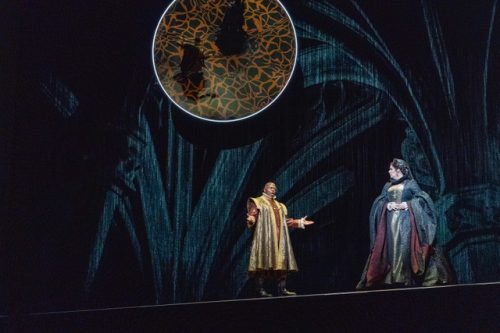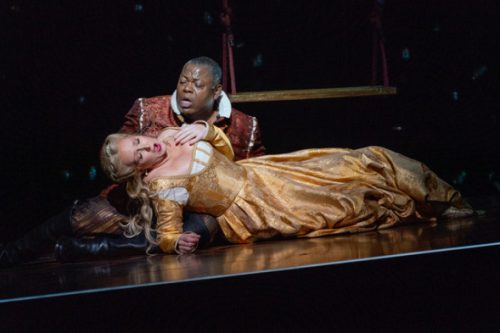
[ad_1]
 United States Saint-Saëns, Henri VIII: Soloists, Dancers, Bard Competition Chorale, American Symphony Orchestra / Leon Botstein (conductor). Fischer Middle at Bard, Annandale-on-Hudson, New York, 30.7.2023. (RP)
United States Saint-Saëns, Henri VIII: Soloists, Dancers, Bard Competition Chorale, American Symphony Orchestra / Leon Botstein (conductor). Fischer Middle at Bard, Annandale-on-Hudson, New York, 30.7.2023. (RP)

Manufacturing:
Director – Jean-Romain Vesperini
Units – Bruno de Lavenère
Costumes – Alain Blanchot
Hair and Make-up – Anika Seitu
Lighting – Christophe Chaupin
Video Projection – Studio AE (Étienne Guiol with Thomas Ocampo)
Refrain grasp – James Bagwell
Forged:
Henri VIII – Alfred Walker
Catherine d’Aragon – Amanda Woodbury
Anne Boleyn – Lindsay Ammann
Don Gómez de Feria – Josh Lovell
Cranmer – Kevin Thompson
Duke of Norfolk – Harold Wilson
Woman Clarence – Alaysha Fox
Cardinal Campeggio – Christian Zaremba
Earl of Surrey – Rodell Rosel
Garter King of Arms – Aaron Blake
Dancers – Joyce Edwards, Lindsey Jones, Doug LeCours, Brandon Washington (Dance Captain)
Wind Ensemble: Andrea Ábel (flute), Michał Cieślik (oboe), Eszter Pókai (clarinet), Philip McNaughton (bassoon), Alberto Arias Flores (horn)
Absolutely-staged opera performances are uncommon throughout the summer time in New York, however one want solely enterprise a bit north up the Hudson River to get a repair on the Bard SummerScape. Each summer time, its founder and music director, Leon Botstein, presents operatic rarities in vibrant productions with thrilling casts. This 12 months was no exception, the draw being Saint-Saëns’s Henri VIII, which the composer himself thought of considered one of his best creations.
The motion facilities on Henry VIII’s efforts to rid himself of his first spouse, Catherine of Aragon, and wed the a lot youthful and beguiling Anne Boleyn. It’s best to not fret over historic accuracy within the libretto by Léonce Détroyat and Armand Silvestre, which was primarily based on El cisma en Inglaterra (1627) by Pedro Calderón de la Barca. The historic gist is there, nevertheless, and gives greater than ample dramatic gasoline. Much more engaging is the opera’s endless movement of lovely melodies, wealthy and delicate orchestrations and stirring choral scenes.
Jean-Romain Vesperini’s idea for Henri VIII leaned in the direction of the standard however with sufficient fashionable touches to raise the manufacturing from the realm of comfy interval drama. He appeared to create two completely different spheres of consciousness – a standard one the place the royal court docket functioned considerably rationally, and a much more ominous, mysterious realm the place hazard lurked.
The standard components have been the tile flooring, furnishings and Alain Blanchot’s luxurious costumes. Essentially the most spectacular one was the rose window that dominated the stage whereas a synod heard proof and finally dominated favorably on the king’s divorce petition from Catherine, the primary of his six wives.
The modern was launched via a circle and an archway. The circle might be remodeled right into a mirror that mirrored the motion beneath or outlined in pure white gentle to create a somber celestial object, whereas the archway functioned primarily as a door. Vesperini and his group labored magic with plenty of hanging beads that served each as partitions and screens. There was rather a lot occurring visually on this manufacturing, nevertheless it was neither overwhelming nor distracting.

Alfred Walker’s Henry was dashing however a tyrant. There have been softer edges to this king, reminiscent of tender love scenes with Anne or fleeting, self-serving regret over Catherine’s destiny, however envy, suspicion and violence have been ever-present. Walker’s wealthy bass-baritone is lower of noble material, able to expressing rage or ardour in scintillating sound. There was no self-doubt in Walker’s monarch, who ended the opera in a fierce invocation of the axe as his political and private instrument of alternative.
Equally regal was Amanda Woodbury’s Catherine, whose lyric soprano flowed freely as she expressed the wronged lady’s pleasure, defiance and keenness for each her Catholic religion and her husband. Saint-Saëns made Catherine essentially the most sympathetic character within the opera, not solely evident within the magnanimity which the queen exhibited to her rival as she was dying, but in addition in her eager for the nation by which she was born. In each scene by which she appeared; Woodbury gained the viewers’s coronary heart.
Anne Boleyn is usually portrayed as having darkish hair, however Lindsay Ammann has flowing golden locks that matched the costume she wore. It was not her look alone that made Ammann the main focus in each scene by which she appeared: slightly, it was her distinctive, attention-grabbing voice and its fascinating decrease vary. The distinction between Woodbury’s and Ammann’s voices and temperaments made their scenes collectively riveting.
On the middle of the plot is the concealment of Anne’s earlier tryst with Don Gómez de Feria, portrayed by Josh Lovell. His advantageous lyric tenor and pure ease on stage made for a successful mixture. Bass Harold Wilson was a stalwart Duke of Norfolk, as was tenor Rodell Rosel’s Earl of Surrey.
Christian Zaremba made a very dashing Cardinal Campeggio, the papal legate who informs Henry VIII that the pope won’t grant him a divorce and, moreover, has excommunicated him. Because the Garter King of Arms, Aaron Blake’s tenor additionally demanded consideration.
Saint-Saëns researched the English music of the period, and he included people tunes and airs into the rating, lending it each magnificence and charm. Botstein led the American Symphony Orchestra in a efficiency that emphasised these components. The ASO’s brass performed the stately fanfares that course via the opera with panache. Equally spectacular was the singing of the Bard Competition Chorale which added dramatic impetus and aural magnificence to the opera.
Dance was an integral a part of French grand opera, and Saint-Saëns provided the compulsory ballet to conclude the second act. Quite than present leisure for the papal legate, Botstein selected to have it carried out within the foyer throughout intermission. An ensemble of Bard Faculty college students and alums carried out the dances in Sebastian Danila’s association for wind quintet. The mild strains of their enjoying transported one to Tudor England, even when that they had a slight French accent.
Rick Perdian
[ad_2]